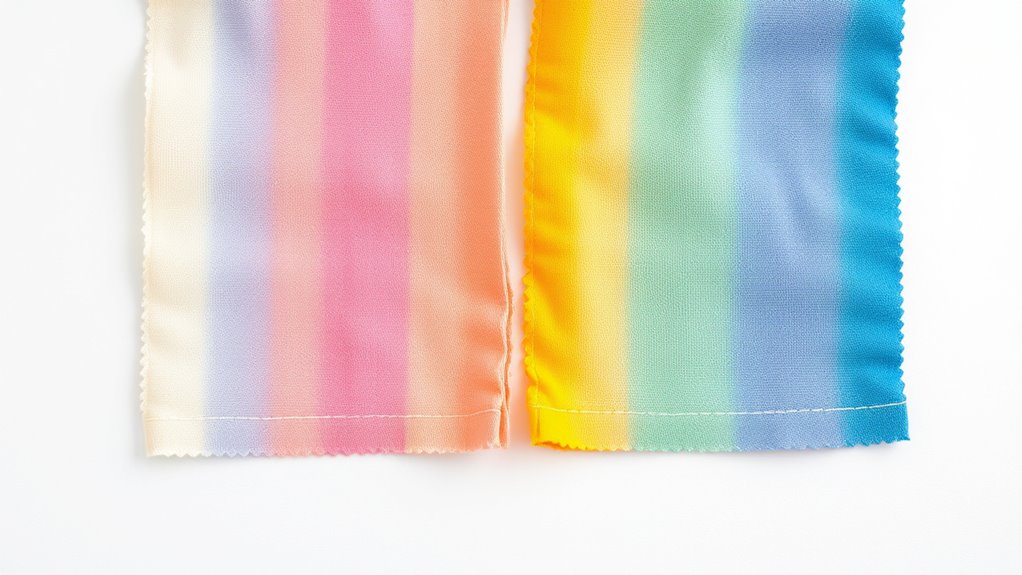To prevent color bleeding, you can try salt soaks or vinegar rinses. Salt soaks involve soaking new, brightly dyed clothes in cold water with half a cup of salt per gallon, helping set the dye. Vinegar rinses use a cup of white vinegar in the rinse cycle or a soak in a vinegar-water mix to act as a natural dye fixative. Both methods are effective, but each suits different fabric types—learn more to choose the best for your garments.
Key Takeaways
- Salt soaks are effective for new, heavily dyed clothes and are simple to implement.
- Vinegar rinses are gentler, ideal for delicate fabrics and color preservation.
- Salt helps set dyes by stabilizing color, while vinegar acts as a natural fixative to prevent bleeding.
- Choose salt for quick, robust treatment; opt for vinegar for more delicate or sensitive fabrics.
- Both methods are eco-friendly and can be combined with cold water washing to enhance color retention.

Have you ever washed a new piece of clothing only to find its color bleeding onto other garments? It’s a frustrating experience, but understanding how to prevent this can save you time and money. When it comes to dealing with fabric dyes and keeping colors vibrant, two popular methods are salt soaks and vinegar rinses. Both techniques aim to lock in dye and prevent bleeding, but they work differently and suit different situations.
Salt soaks are a tried-and-true method that you can easily try at home. When you soak your new clothes in a saltwater solution before washing, you help set the fabric dyes, reducing the chance of color bleeding. To do this, fill a basin with cold water and add about half a cup of salt per gallon. Submerge your garment and let it soak for about 30 minutes. After soaking, wash the item separately or with similar colors. This method is especially effective for bright or dark dyes prone to bleeding. It’s also a simple, inexpensive way to protect your clothes from color transfer, and it aligns well with good washing machine tips—like always washing new clothes separately until you’re sure they won’t bleed.
Soak new clothes in saltwater before washing to prevent color bleeding and protect your garments.
Vinegar rinses are another popular approach, especially for delicate fabrics or when you want to preserve the vibrancy of your colors. White vinegar acts as a natural fixative, helping to lock in dye molecules. To use this method, add one cup of white vinegar to your washing machine’s rinse cycle or soak your clothing in a mixture of one part vinegar to four parts water for about 30 minutes before washing. This process helps set the dyes and prevents bleeding, particularly with reds, purples, or deep blues. Just be cautious with delicate fabrics, as vinegar might cause some fibers to weaken over time. Vinegar rinses are a gentle and eco-friendly option that can be incorporated into your regular laundry routine, especially if you’re concerned about color bleeding after the initial wash.
Additionally, understanding the role of automation in laundry processes can help optimize your washing routine by reducing manual interventions and ensuring consistent results. Both salt soaks and vinegar rinses serve to stabilize fabric dyes and minimize bleeding, but the choice depends on the fabric type and dye intensity. Salt soaks are excellent for new, heavily dyed clothes and are a straightforward way to improve your laundry results. Vinegar rinses, meanwhile, provide a softer fix that can help preserve color vibrancy over multiple washes. Incorporating these tips into your laundry routine, along with other washing machine tips like washing similar colors together and using cold water, can help you keep your clothes looking fresh and vibrant longer. Ultimately, taking these simple steps ensures your wardrobe stays colorful without unexpected surprises in the laundry.
Frequently Asked Questions
Can Salt or Vinegar Damage Delicate Fabrics?
You might wonder if salt or vinegar can damage delicate fabrics. While both are generally safe when used properly, they can cause issues if misapplied. Salt usually offers fabric safety by helping set colors, but too much or prolonged contact can weaken fibers. Vinegar’s acidity can lead to chemical reactions that damage sensitive fabrics, especially if used in high concentrations. Always test a small area first to avoid unintended damage.
How Often Should I Soak Clothes to Prevent Bleeding?
You should soak your clothes periodically to prevent bleeding, usually once every few months or if you notice color transfer. The ideal intervals depend on how often you wash your clothes and their fabric type. For delicate or new garments, a soak every 4-6 washes can help maintain color. Avoid over-soaking, as this can weaken fibers; instead, stick to a regular schedule based on your laundry habits.
Are There Specific Colors That Are More Prone to Bleeding?
Think of some colors as rebellious kids—more prone to dye migration and causing chaos in your laundry. Bright reds, vibrant blues, and deep purples often face more colorfastness issues, making them more susceptible to bleeding. These hues act like magnetic fields for dye, so you need extra care. To keep your clothes looking fresh, wash these colors separately or use treatments like salt soaks or vinegar rinses to strengthen their dye bonds.
Can Commercial Color Fixatives Replace Salt or Vinegar?
Commercial color fixatives can be a helpful tool for DIY dye prevention, but they don’t fully replace salt or vinegar rinses. These household methods work by sealing dye within fibers, reducing bleeding. While some fixatives claim to lock in color, they may not be as effective for all fabrics or dyes. Using a combination of commercial fixatives and traditional salt or vinegar rinses offers the best chance to prevent color bleeding.
Do Homemade Remedies Work Equally Well for All Types of Dyes?
Ever wonder if homemade remedies really work for all dyes? The truth is, it depends on fabric type and dye stability. Some fabrics respond well to salt or vinegar, but others may not. While these remedies can sometimes prevent bleeding, they aren’t foolproof for every dye or fabric. You need to take into account the specific material and dye’s properties to choose the right approach. Don’t assume one size fits all.
Conclusion
Now that you know the tricks, your clothes are safer than ever. But which method truly seals in those vibrant hues? Salt soaks or vinegar rinses—could one be more effective than the other? The answer isn’t as simple as it seems, and your choice might just surprise you. The real secret lies in understanding your fabrics and dyes. Ready to dive deeper? The next wash could change everything—if you dare to experiment.









